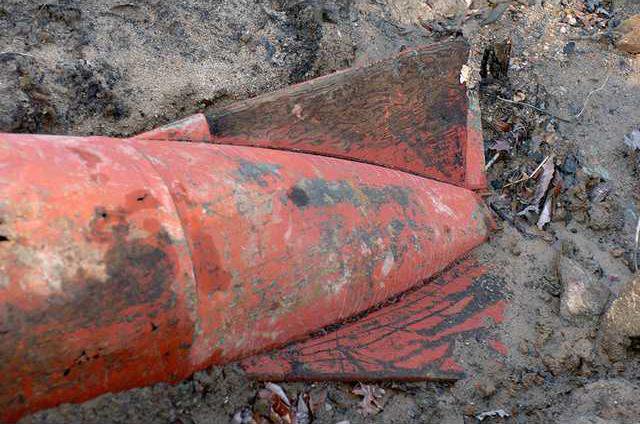0115HOOKAUDgalley
Flowery Branch resident Alan Galley discusses what he believes to be a World War II-era fuel tank he found in Lake Lanier.0115HOOKAUDbentley
Flowery Branch resident Vicki Bentley reveals the details of the day she came across a prosthetic hand-hook in Lake Lanier.For 50 years, mysteries have been lurking in the cloudy depths of Lake Lanier.
And now, with the lake levels 20 feet below full pool, those mysteries are beginning to surface, one strange find at a time.
Flowery Branch resident Vicki Bentley was trawling the shores with a friend on an island near Thompson Bridge Park in early December when a shiny object caught her eye.
"We just walk along the shoreline and pick up fishing lures, golf balls, garbage and fishing lead weights," Bentley said. "And there this hook was, sticking up out of the silt.
"At first, it was more like ‘What is that?’" Bentley said. "And then it’s like, ‘Oh my gosh! It’s a hand!’"
Bentley said once she removed it from the sediment, she could see a leather sheath that would fit down over the lower arm with a Velcro strap to tighten it.
"At that point, it became obvious it was a hand — a hook — a prosthetic," Bentley said.
Bentley said the hook is possibly made of stainless steel, and is in excellent condition. Amazingly, she said, the leather is in reasonably good condition, but the Velcro is badly damaged.
Bentley found the prosthetic hook-hand in an area frequented by fisherman that, at full pool, would be about 15 feet under water, she estimated.
"It is the most unusual thing I’ve found in 40 years of beachcombing," she said. "What does one do with one of these? I’m not exactly sure what to do with it. I’m not inclined to toss it in the garbage ... and it’s not exactly the type of thing you donate to Goodwill."
Bentley said the prosthetic piece had no serial numbers or identification marks on it that would enable her to determine its owner. Bentley also said she found a small cable in the same cove where she discovered the hook-hand, and believes the cable, which has a lever on it, could have been used in conjunction with the prosthetic piece.
"It’s presumably of some value," she said.
And she’s right. According to Dan Zenas of Georgia Prosthetics in Atlanta, a body-powered prosthetic hook-hand controlled by a cable wrapped around the opposite arm pit would cost about $3,500 today.
Zenas, a licensed prostheticist, said the piece would have been custom-made for somebody whose arm was amputated at the wrist. He added that prosthetic hook pieces are still issued today, but the leather sheath on the cable-powered device Bentley found possibly dates the device to 40 years ago.
"The configuration of that hook has not changed in many years," Zenas said. "The component that dates it as being more modern is the Velcro strap. It could be as much as 30 or 40 or as little as five years old. But with the Velcro strap, I think it’s about 20 years old."
Zenas said serial numbers are not typically inscribed on low-tech prosthetic limbs.
"I’m imagining this person could’ve been reaching over the boat to pull out a large fish, and the weight of the fish could’ve pulled the arm right off of him," Zenas said.
As bizarre a find as Bentley stumbled upon, there’s still more lurking in the lake.
Alan Galley of Flowery Branch was exploring the lakeside trails behind his home in the Four Seasons subdivision off Gaines Ferry Road when he caught sight of an orange-colored torpedo-like object protruding from the bank.
Shortly after Christmas, Galley said water from recent rains created a stream near his home that poured into the lake. The resulting erosion uncovered a 10-foot-long by 18-inch-wide "bomb-shaped" metal item.
"I’m pretty sure that what we found was an airplane external auxiliary fuel tank," Galley said. "It appears that — because it’s made out of metal rather than aluminum, and it has plywood fins — more than likely it was from around the World War II era."
Galley said he believes the fuel tank was a training device accidentally dropped by U.S. Navy airplanes practicing at the Navy training center that operated at Lee Gilmer Memorial Airport between 1943 and 1947. During that four-year period, the U.S. Navy leased the airport land and its dirt airstrip from the city of Gainesville for $1, according to the city of Gainesville Web site. The Navy constructed 4,000-foot paved runways with parallel taxiways, aircraft and electronics maintenance facilities, barracks and related support facilities.
The base served as a satellite of the Naval Air Station at what is now DeKalb-Peachtree Airport. The Navy-built aircraft maintenance hangar still stands at the airport.
Galley said the fuel tank he discovered was probably located under the wing of an airplane and was used by the Navy to extend planes’ mission distance in cross-country or cross-Atlantic flights. During the 1940s, he explained, engines did not have the fuel efficiency they do now.
"It’s the type of tank that could be dropped before they get into a mission or dogfight," Galley added. "It’s not like a bomb or anything; it just holds fuel."
Galley said the fuel tank was resting under 2 to 3 feet of sediment, and had embedded itself into the bank of a hill and was lodged into place by small trees.
"This thing was probably underground even before the lake was formed," he said. "And when the lake was formed, it of course put more silt on top of it. So it’s been there a long time. If it hadn’t been for this drought and erosion that occurred in the basin because of these low levels, this probably never would have surfaced."

